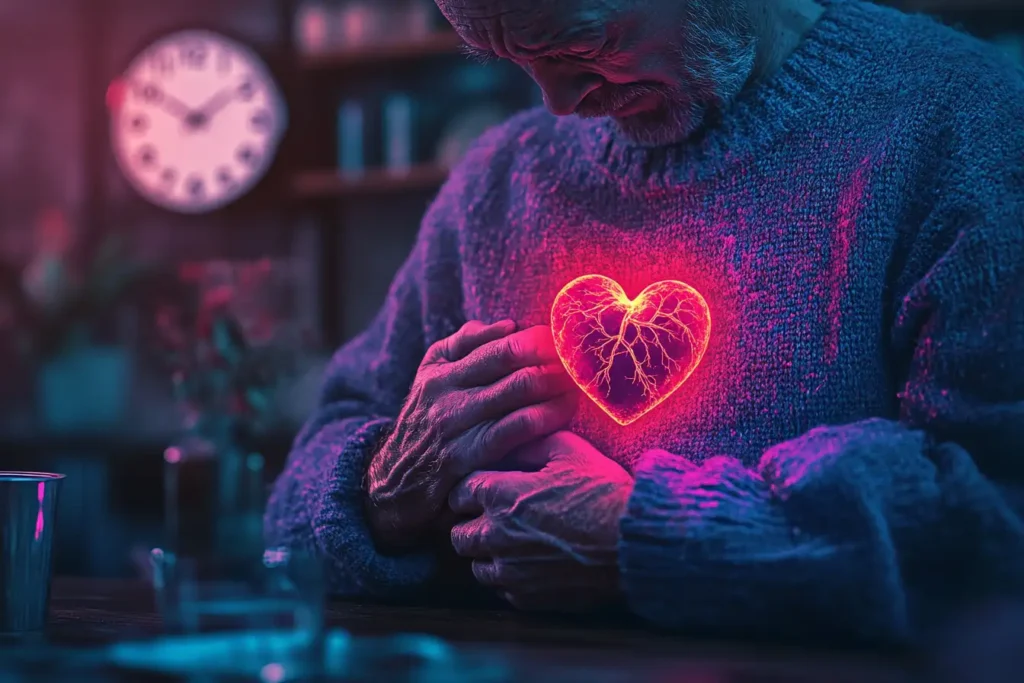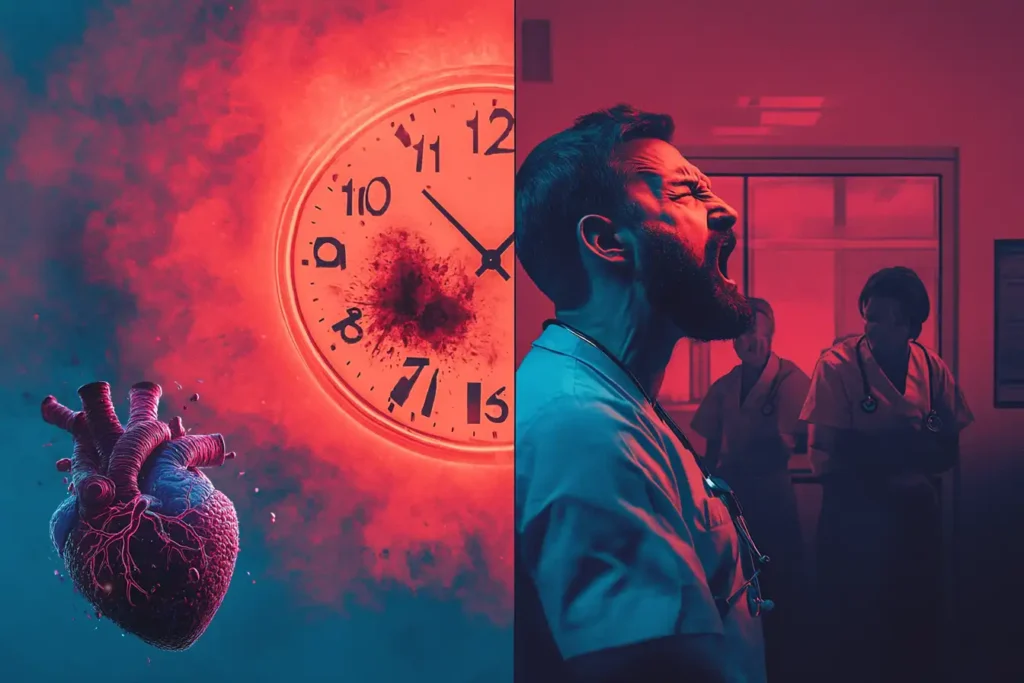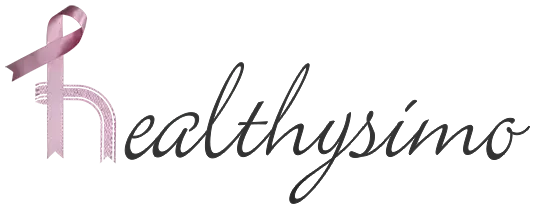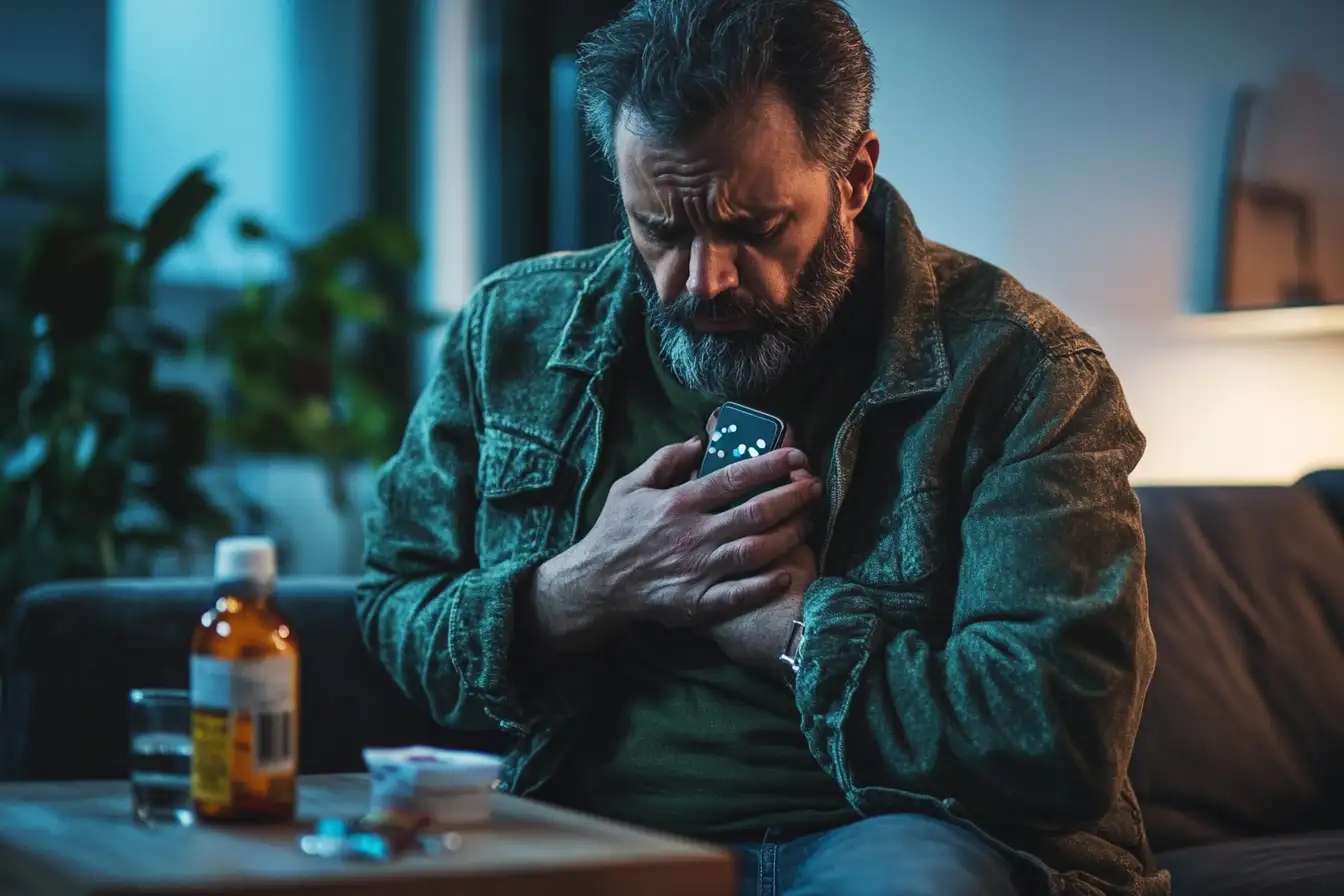A heart attack is a terrifying experience, but it’s even more daunting if you’re alone. Every second counts, and knowing what to do could mean the difference between life and death. In this Heart Attack Survival Guide, we’ll walk you through the critical steps to take if you experience a heart attack while alone. From recognizing the symptoms to calling for help and staying calm, this guide is packed with life-saving tips to help you survive—and thrive—during a medical emergency. Let’s get started.
Heart Attack Survival Guide:Understanding Heart Attacks
A heart attack, medically referred to as a myocardial infarction, is a life-threatening event that occurs when blood flow to the heart is severely reduced or completely blocked. This blockage is typically caused by a blood clot forming in a coronary artery, which supplies oxygen-rich blood to the heart muscle. When the heart is deprived of oxygen, the affected tissue begins to die, leading to permanent damage or even death if not treated promptly.
The heart is a vital organ, and its proper function is essential for survival. When blood flow is interrupted, even for a few minutes, the consequences can be devastating. This is why immediate medical intervention is critical to restore blood flow, minimize damage, and save lives.
What Happens During a Heart Attack?
To fully understand a heart attack, it’s important to know how the heart functions. The heart relies on a network of coronary arteries to deliver oxygen and nutrients to its muscle tissue. When one or more of these arteries become blocked—usually due to a buildup of plaque (a mixture of fat, cholesterol, and other substances)—the heart muscle is starved of oxygen.
Here’s a step-by-step breakdown of what occurs during a heart attack:
- Plaque Rupture: The plaque lining the artery walls can rupture, causing a blood clot to form at the site of the rupture.
- Blockage: The clot can partially or completely block the artery, preventing blood from reaching the heart muscle.
- Ischemia: The lack of blood flow leads to ischemia, a condition where the heart muscle is deprived of oxygen.
- Tissue Damage: If blood flow isn’t restored quickly, the affected heart tissue begins to die, leading to permanent damage.
This process underscores the importance of recognizing the symptoms and seeking immediate medical attention.

Common Symptoms of a Heart Attack
Heart attack symptoms can vary widely from person to person, but there are several common signs to watch for. Recognizing these symptoms early can make all the difference in saving a life.
1. Chest Pain or Discomfort
- Description: Often described as pressure, squeezing, tightness, or a heavy weight on the chest.
- Location: Typically felt in the center or left side of the chest.
- Duration: May last more than a few minutes or come and go.
This is the most classic symptom of a heart attack, but it’s important to note that not everyone experiences chest pain.
2. Pain in Other Areas
- Arms: Pain or discomfort may radiate to one or both arms, particularly the left arm.
- Back: Pain can spread to the upper back, between the shoulder blades.
- Neck or Jaw: Some people experience pain in the neck, jaw, or throat.
- Stomach: Discomfort may also be felt in the upper abdomen, often mistaken for indigestion.
3. Shortness of Breath
- This symptom can occur with or without chest pain.
- It may feel like you can’t catch your breath, even when resting.
4. Other Symptoms
- Cold Sweats: Sudden, unexplained sweating, often described as a “cold sweat.”
- Nausea or Vomiting: Feeling sick to your stomach or actually vomiting.
- Lightheadedness or Dizziness: Feeling faint or unsteady on your feet.
- Fatigue: Unusual or extreme tiredness, sometimes occurring days or weeks before the heart attack.
- Feeling of Impending Doom: A sense that something is terribly wrong.
Atypical Symptoms in Women
While both men and women can experience the symptoms listed above, women are more likely to have atypical symptoms that are often overlooked or mistaken for other conditions. These include:
- Fatigue: Extreme tiredness that doesn’t improve with rest.
- Indigestion or Heartburn: A burning sensation in the chest or stomach.
- Upper Back Pain: Pain between the shoulder blades.
- Flu-Like Symptoms: Feeling generally unwell, with no clear cause.
Because these symptoms are less obvious, women may delay seeking help, which can lead to worse outcomes. It’s crucial to listen to your body and seek medical attention if something feels off.
Why Symptoms Vary
Heart attack symptoms can differ based on several factors, including:
- Age: Older adults may experience less obvious symptoms, such as fatigue or confusion.
- Gender: Women are more likely to have atypical symptoms.
- Underlying Health Conditions: People with diabetes may have fewer noticeable symptoms due to nerve damage.
- Severity of the Blockage: A partial blockage may cause milder symptoms, while a complete blockage can lead to severe pain and rapid deterioration.
The Importance of Acting Quickly
The key to surviving a heart attack is acting quickly. Every minute counts when it comes to restoring blood flow to the heart. Delaying treatment can lead to:
- Permanent Heart Damage: The longer the heart is deprived of oxygen, the more tissue dies.
- Heart Failure: Damaged heart muscle can weaken the heart’s ability to pump blood.
- Death: In severe cases, a heart attack can be fatal if not treated promptly.
If you or someone else experiences symptoms of a heart attack, don’t wait—call emergency services immediately.
Can You Survive a Heart Attack Alone?
Surviving a heart attack alone is challenging but not impossible. The biggest hurdles are the inability to call for help immediately and the delay in receiving medical attention. According to the American Heart Association, nearly half of all heart attack deaths occur before the person reaches the hospital. However, with the right knowledge and preparation, you can significantly improve your chances of survival.
The key is to act fast. The sooner you recognize the symptoms and take action, the better your chances of survival. This guide will equip you with the tools and knowledge you need to navigate this life-threatening situation.
Immediate Steps to Take During a Heart Attack Alone
If you suspect you’re having a heart attack and you’re alone, follow these steps:
1. Call for Help
- Dial emergency services (911 or your local emergency number) immediately.
- If you’re unable to speak, use voice commands on your smartphone or smart device to call for help. Many devices allow you to activate emergency calls with simple voice prompts like “Hey Siri, call 911.”
2. Chew Aspirin
- If you have aspirin on hand and your doctor has recommended it, chew one regular-strength aspirin (325 mg). Aspirin helps thin your blood and can reduce further clotting, which may limit the damage to your heart.
3. Stay Calm
- Panicking can worsen your condition by increasing your heart rate and blood pressure. Take slow, deep breaths to stay calm and conserve energy. Focus on the steps you need to take to get help.
4. Cough CPR (If Advised)
- In some cases, coughing vigorously can help maintain blood flow to the heart. However, this technique is controversial and should only be used if advised by a medical professional.
5. Position Yourself
- Sit or lie down in a comfortable position. Avoid standing or walking, as this can strain your heart. If possible, lean forward slightly to ease breathing.
Recognizing the Signs of a Heart Attack
Early recognition of Early recognition of heart attack symptoms is absolutely critical. A heart attack is a medical emergency where every second counts, and ignoring warning signs—no matter how mild they may seem—can have devastating consequences. Understanding the symptoms and acting quickly can mean the difference between life and death.
Here’s a detailed look at the most common signs of a heart attack, as well as why it’s so important to take them seriously.
Common Symptoms of a Heart Attack
1. Chest Discomfort
- What It Feels Like: A sensation of pressure, squeezing, tightness, or heaviness in the chest. Many people describe it as feeling like an elephant is sitting on their chest.
- Location: Typically centered in the middle or left side of the chest.
- Duration: The discomfort may last for several minutes or come and go in waves.
Chest discomfort is the most classic and widely recognized symptom of a heart attack. However, it’s important to note that not everyone experiences this symptom, and some people may only feel mild discomfort or none at all.
2. Pain in Other Areas
Heart attack pain isn’t always confined to the chest. It can radiate to other parts of the body, including:
- Arms: Pain or discomfort may spread to one or both arms, with the left arm being more commonly affected.
- Back: Pain can occur between the shoulder blades or in the upper back.
- Neck or Jaw: Some people experience pain in the neck, jaw, or throat, which may feel like a dull ache or pressure.
- Stomach: Discomfort in the upper abdomen is also possible and is often mistaken for indigestion or heartburn.
This type of pain is often referred to as referred pain, meaning it’s felt in areas other than where the problem originates.
3. Shortness of Breath
- What It Feels Like: Difficulty breathing, even when at rest. It may feel like you can’t catch your breath or are gasping for air.
- Connection to Chest Pain: Shortness of breath can occur with or without chest discomfort.
This symptom is particularly common in women and older adults. It may be the only noticeable sign of a heart attack in some cases.
4. Other Symptoms
In addition to the more well-known symptoms, a heart attack can also cause:
- Cold Sweats: Sudden, unexplained sweating that feels cold and clammy.
- Nausea or Vomiting: Feeling sick to your stomach or actually vomiting.
- Lightheadedness or Dizziness: Feeling faint, unsteady, or like you might pass out.
- Fatigue: Extreme, unexplained tiredness that doesn’t improve with rest.
- Sense of Impending Doom: A feeling that something is terribly wrong, often accompanied by anxiety or panic.
These symptoms can occur alone or in combination with chest pain and other signs. They are often overlooked or attributed to less serious conditions, which is why it’s so important to pay attention to your body.

Why Early Recognition is Crucial
Heart attacks are a leading cause of death worldwide, but many of these deaths are preventable with prompt treatment. The sooner you recognize the symptoms and seek medical help, the better your chances of survival and recovery.
The Golden Hour
The first hour after a heart attack is often referred to as the “golden hour” because prompt treatment during this time can:
- Restore Blood Flow: Reopen blocked arteries and minimize damage to the heart muscle.
- Save Lives: Reduce the risk of complications like heart failure or cardiac arrest.
- Improve Recovery: Increase the likelihood of a full recovery with fewer long-term effects.
Delaying treatment, on the other hand, can lead to:
- Permanent Heart Damage: The longer the heart is deprived of oxygen, the more tissue dies.
- Heart Failure: Damaged heart muscle can weaken the heart’s ability to pump blood effectively.
- Death: In severe cases, a heart attack can be fatal if not treated promptly.
What to Do If You Experience Symptoms
If you or someone else experiences any of the symptoms listed above, don’t wait—seek help immediately. Here’s what to do:
- Call Emergency Services: Dial 911 or your local emergency number right away.
- Chew Aspirin: If you have aspirin on hand and your doctor has recommended it, chew one regular-strength aspirin (325 mg) to help thin your blood.
- Stay Calm: Try to remain as calm as possible while waiting for help to arrive.
- Rest: Sit or lie down in a comfortable position to avoid straining your heart.
A Word of Caution
It’s always better to be cautious and seek medical attention, even if you’re unsure whether your symptoms are caused by a heart attack. Many people hesitate to call for help because they don’t want to overreact or fear being wrong. However, the consequences of ignoring a heart attack far outweigh the inconvenience of a false alarm.
Why Time is Critical
The first hour after a heart attack is often called the “golden hour” because prompt treatment during this time can save lives and minimize heart damage. Delaying treatment can lead to severe complications, including heart failure or even death.
What Happens During the Golden Hour?
- Restoring blood flow: Quick medical intervention can reopen blocked arteries and restore blood flow to the heart.
- Minimizing damage: The sooner treatment begins, the less damage the heart muscle sustains.
- Improving survival rates: Studies show that patients who receive treatment within the first hour have significantly higher survival rates.
Acting quickly is your best chance for survival. Every minute counts.
Preparing for a Heart Attack When Alone
If you’re at risk for a heart attack, take these steps to prepare:
1. Save Emergency Contacts
- Program emergency numbers into your phone and keep a list by your bedside.
2. Wear a Medical ID
- A medical ID bracelet or necklace with your medical information can help first responders provide the right care.
3. Inform Neighbors or Friends
- Let trusted neighbors or friends know about your condition so they can check on you if needed.
4. Use Smart Devices
- Smartwatches and home devices with emergency alert features can automatically call for help if they detect a problem.
What Not to Do During a Heart Attack
- Don’t Drive Yourself: You could lose consciousness and put yourself and others at risk.
- Don’t Ignore Symptoms: Even mild symptoms can indicate a serious problem.
- Don’t Exert Yourself: Avoid physical activity, as it can strain your heart.
Long-Term Prevention Tips
Reducing your risk of a heart attack starts with a healthy lifestyle:
- Eat a balanced diet: Focus on fruits, vegetables, whole grains, and lean proteins.
- Exercise regularly: Aim for at least 30 minutes of moderate exercise most days of the week.
- Quit smoking: Smoking is a major risk factor for heart disease.
- Limit alcohol: Excessive drinking can increase your risk of heart problems.
- Manage stress: Practice relaxation techniques like meditation or yoga.
- Schedule regular check-ups: Monitor your blood pressure, cholesterol, and blood sugar levels.
Real-Life Stories of Surviving a Heart Attack Alone
“John, a 58-year-old accountant, was home alone when he felt a sharp pain in his chest. Remembering what he’d read about heart attacks, he immediately called 911, chewed an aspirin, and stayed calm until help arrived. Thanks to his quick thinking, John survived and is now an advocate for heart health education.”
Stories like John’s remind us that preparation and knowledge can save lives.
Frequently Asked Questions (FAQs)
1. Can coughing really help during a heart attack?
Cough CPR is controversial and should only be used if advised by a medical professional.
2. What should I do if I live alone and have a heart attack?
Call emergency services immediately, chew aspirin if recommended, and stay calm until help arrives.
3. How can I reduce my risk of having a heart attack?
Adopt a healthy lifestyle, including a balanced diet, regular exercise, and routine health check-ups.
Conclusion
Surviving a heart attack alone is challenging, but it’s possible with the right knowledge and preparation. By recognizing the symptoms, acting quickly, and taking steps to reduce your risk, you can protect your heart and improve your chances of survival. Share this Heart Attack Survival Guide with your loved ones—it could save a life.


you are in reality a excellent webmaster. The website loading speed is incredible. It seems that you are doing any distinctive trick. Moreover, The contents are masterwork. you’ve performed a great activity on this matter!
Thank you so much for your kind words! I’m thrilled to hear that you’re enjoying the website’s performance and content. Speed and quality are always top priorities, so it’s great to know that the effort is paying off. Your feedback truly means a lot and motivates me to keep improving. If you have any suggestions or need assistance, feel free to reach out. Thanks again for your support! 😊
you are in reality a excellent webmaster. The website loading speed is incredible. It seems that you are doing any distinctive trick. Moreover, The contents are masterwork. you’ve performed a great activity on this matter!
Thank you so much for your kind words! I’m thrilled to hear that you’re enjoying the website’s performance and content. Speed and quality are always top priorities, so it’s great to know that the effort is paying off. Your feedback truly means a lot and motivates me to keep improving. If you have any suggestions or need assistance, feel free to reach out. Thanks again for your support! 😊
Does your website have a contact page? I’m having problems locating it but, I’d like to send you an e-mail. I’ve got some recommendations for your blog you might be interested in hearing. Either way, great blog and I look forward to seeing it expand over time.
Hi there, and thank you so much for your kind words!
I’m really glad you’re enjoying the blog and I truly appreciate your interest in contributing.
Yes — my website does have a Contact page!
You can reach me directly here: 👉 https://healthysimo.com/contact/
Feel free to send your suggestions or recommendations — I always welcome feedback that helps improve the experience for my readers.
Looking forward to hearing from you soon!
Warm regards,
The HealthySimo Team 🌿
Does your website have a contact page? I’m having problems locating it but, I’d like to send you an e-mail. I’ve got some recommendations for your blog you might be interested in hearing. Either way, great blog and I look forward to seeing it expand over time.
Hi there, and thank you so much for your kind words!
I’m really glad you’re enjoying the blog and I truly appreciate your interest in contributing.
Yes — my website does have a Contact page!
You can reach me directly here: 👉 https://healthysimo.com/contact/
Feel free to send your suggestions or recommendations — I always welcome feedback that helps improve the experience for my readers.
Looking forward to hearing from you soon!
Warm regards,
The HealthySimo Team 🌿
Those are yours alright! . We at least need to get these people stealing images to start blogging! They probably just did a image search and grabbed them. They look good though!
Thank you for your observation. Yes, these visuals are indeed custom-created for our content. We’ve invested significant effort in ensuring that each image aligns precisely with the subject matter and message of the article. While it’s unfortunate that some individuals may resort to using images without permission, we hope it inspires them to explore more constructive and original avenues—such as creating their own content. We appreciate the positive feedback on the quality of the visuals.
Those are yours alright! . We at least need to get these people stealing images to start blogging! They probably just did a image search and grabbed them. They look good though!
Thank you for your observation. Yes, these visuals are indeed custom-created for our content. We’ve invested significant effort in ensuring that each image aligns precisely with the subject matter and message of the article. While it’s unfortunate that some individuals may resort to using images without permission, we hope it inspires them to explore more constructive and original avenues—such as creating their own content. We appreciate the positive feedback on the quality of the visuals.